Winter Olympics 2022: the environmental impact of fake snow, how it’s made and why it poses a risk to athletes
and live on Freeview channel 276
Beijing has made history this year as the first host of the Winter Olympics to rely almost entirely on artificial snow - a development that could become the norm as the planet warms.
It is estimated that 49 million gallons of water have been used to make the artificial snow for the 2022 Games, despite the capital of China being one of the most water-scarce cities in the world.
Advertisement
Hide AdAdvertisement
Hide AdWith fake snow becoming the norm for the majority of ski resorts globally and its use in Beijing, we take a look at how it is made, its impact on the environment and the risk it poses to athletes.
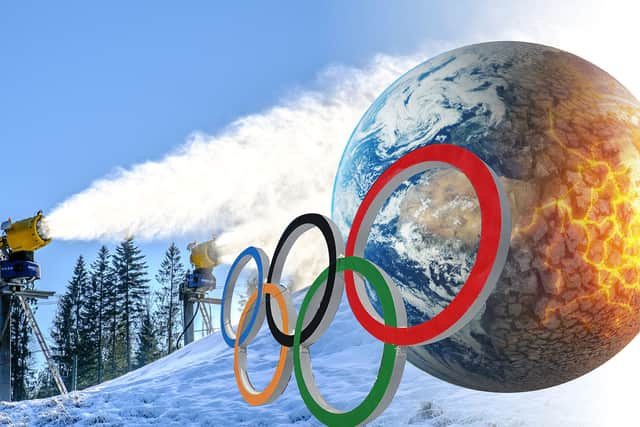

Why is there more reliance on fake snow?
Warming temperatures mean there are less places across the globe where snow and ice sports can take place in natural conditions.
February daytime temperatures of Olympic Winter Games host cities have been increasing steadily from an average of 0.4°C in the 1920s-50s, to 3.1°C during the 60s-90s and 6.3°C in the 21st century.
This has meant that host cities have less natural snow to rely on, using fake snow in its place.
Advertisement
Hide AdAdvertisement
Hide AdFrom the Alps to the Pyrenees, the Rockies to the Andes, snowsports fans are reporting shorter seasons, lower snowfall levels and melting glaciers.
The last Games in Sochi saw temperatures as high as 16ºC.
This year, Beijing has ski slopes set in an area that recorded just 2cm of snowfall between January and March in 2021.
How is fake snow made?
Fake snow was originally invented in a lab in Japan before the US developed machines to distribute it.
The machines contain water pumps and compressors, air plants, piping and snow guns, and need access to both water and electricity.
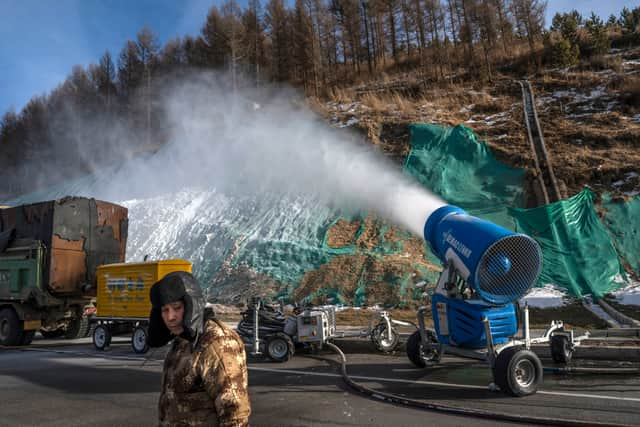

Advertisement
Hide AdAdvertisement
Hide AdTo enhance its ‘quality’, chemicals or biological additives may be added to the water.
Pesticide was added to fake snow used at the 2010 Vancouver Games to allow the water to freeze at high temperatures.
Snow ‘hardeners’ like salt and fertilisers may also be used to improve the quality on cross-country skiing trails.
Why is using fake snow bad for the environment?
An estimated 49 million gallons of water has been used this year in Beijing to create fake snow.
Advertisement
Hide AdAdvertisement
Hide AdThis has alarmed environmentalists because the city is one of the most water-scarce in the world.
Dominic Winter, program manager at Protect Our Winters UK, said: “This is a big drain on a very water-scarce area.”
Even if the use of man-made snow is powered by renewables it will still require a huge amount of energy, which is both costly and a significant drain on water resources.
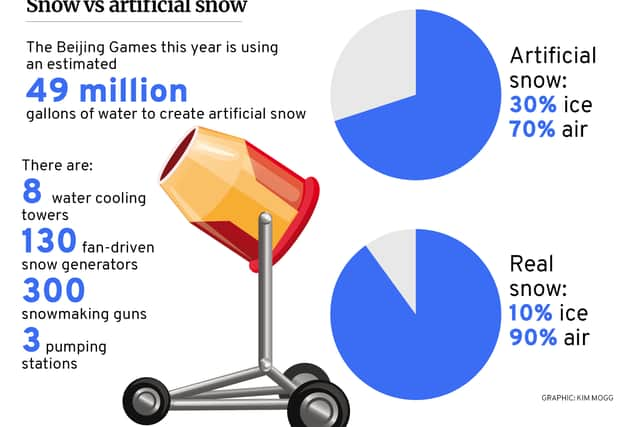

Eight water cooling towers are required, as well as the installation of 130 fan-driven snow generators.
Advertisement
Hide AdAdvertisement
Hide AdThree pumping stations at different altitudes are also needed to feed around 300 snowmaking guns.
However, Beijing organisers responded to the criticism saying that there would be adequate supplies from existing reservoirs and stored run-off - water collected on the ground surface from excess rainwater or melting snow.
In its sustainability report for the Games last year, it said it would use renewable energy for the venues and recycle water resources.
It said: “We shall give priority to ecological and resource conservation, environmental friendliness, and contribute to a beautiful environment.”
Advertisement
Hide AdAdvertisement
Hide AdThe chemical composition of artificial snow can also disrupt vegetation as it remains longer on the ground in the melting season, delaying plant growth.
Mr Winter said: “Chemical or biological additives are sometimes added to artificial snow as they were in the 2010 Games to change its freezing temperature and qualities, which is likely to have local wildlife impacts.
“Not the sort of legacy the Olympics aims to leave.”
The production of artificial snow can increase water runoff in the melting season which can lead to a higher risk of floods and disruption in watersheds.
The noise of snow canons at night can also be harmful to the local wildlife.
What are the other risks of using artificial snow?
Advertisement
Hide AdAdvertisement
Hide AdArtificial snow creates a harder and faster surface, creating a higher risk of severe injuries to athletes.
It is almost 30% ice and 70% air, compared to natural snow which is closer to 10% ice and 90% air.
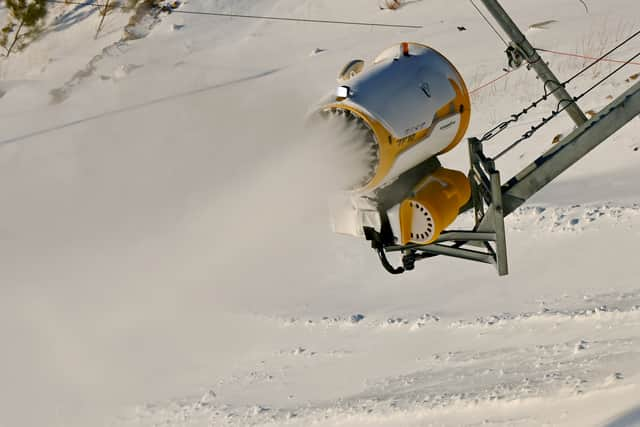

British freestyle skier Laura Donaldson, who competed at the 2002 Salt Lake City Winter Olympics, said athletes are at higher risk of injury when competing on artificial snow.
She said: "If freestyle super pipes are formed from snow-making machines in a poor season, the walls of the pipe are solid, vertical ice and the pipe floor is solid ice.
"This is dangerous for athletes."
Advertisement
Hide AdAdvertisement
Hide AdA superpipe is a large halfpipe structure used in sports such as snowboarding and freestyle skiing.
Freestyle skiers and snowboarders who are flying off jumps or sliding on rails high above the ground prefer the softer surface of natural snow for safety reasons.
The environmental impact of fake snow
Sören Ronge, Europe coordinator at Protect Our Winters Europe, sees artificial snow as an adaptation strategy to the wider issue of climate change and its threat to not only the future of the Winter Olympics but the planet.
He said: “It is important to emphasise that artificial snow is not a long-time solution, but rather an adaptation strategy.
Advertisement
Hide AdAdvertisement
Hide Ad“If we want to safeguard the future of winter sports we need systemic solutions that drastically reduce emissions and mitigate the impacts of climate change”
Mr Ronge added: “Artificial snow uses large amounts of water and energy in its creation, affects landscapes and local ecology and chemicals may need to be added to increase freezing temperatures or for the structure of the snow.
“If temperatures rise even further, producing artificial snow will no longer be possible.”
Mr Winter said: “It would be better to select venues with more natural snow. Snow guns can be good for ensuring resorts remain open during bad spells, damaging holidays and local economies, but it shouldn’t be plan A.”
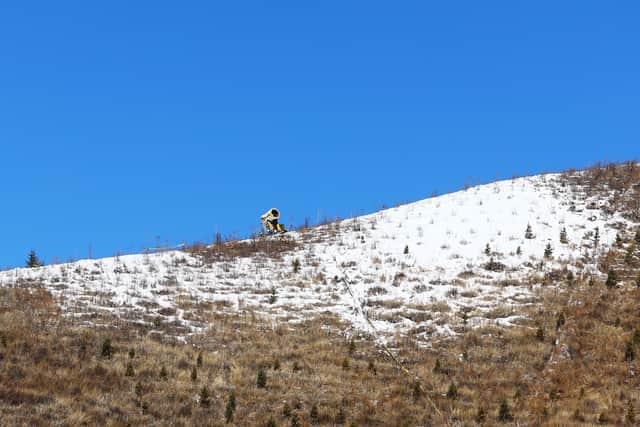

Advertisement
Hide AdAdvertisement
Hide AdThe International Ski Federation said: “The snow-making technology is evolving rapidly and there are already major strides in reducing the amount of energy and water necessary to produce artificial snow.
“The system being used at the 2022 Olympic Winter Games is an excellent example of such technology.”
“Artificial snow isn’t the real issue and it certainly isn’t the answer,” Mr Ronge said.
He added: “If we can significantly reduce emissions by moving to clean energy and transportation, we still have a shot at protecting winter.
“But we have to work together and fast.”
A message from the editor:
Advertisement
Hide AdAdvertisement
Hide AdThank you for reading. NationalWorld is a new national news brand, produced by a team of journalists, editors, video producers and designers who live and work across the UK. Find out more about who’s who in the team, and our editorial values. We want to start a community among our readers, so please follow us on Facebook, Twitter and Instagram, and keep the conversation going. You can also sign up to our newsletters and get a curated selection of our best reads to your inbox every day.
Comment Guidelines
National World encourages reader discussion on our stories. User feedback, insights and back-and-forth exchanges add a rich layer of context to reporting. Please review our Community Guidelines before commenting.
